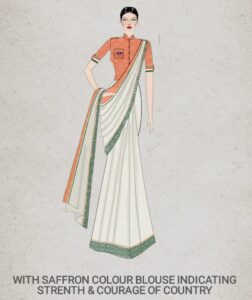In an exciting development, the saree has been reinstated as the official ceremonial uniform for Indian athletes at the Paris Olympics. This decision marks a return to tradition and celebrates the rich cultural heritage of India on the global stage. Here’s a look into the background, reasons for the change, and the anticipated impact of this decision.

Background of the Saree as a Ceremonial Uniform
The saree has a long-standing history as a symbol of Indian culture and identity. Traditionally, it was worn by Indian women in various official and ceremonial functions, including sports events like the Olympics. The elegant drape of the saree represents grace, beauty, and the vibrant diversity of Indian textiles and craftsmanship.
Transition to Western Attire
Over the years, there was a gradual shift from the saree to more Western-style uniforms for Indian athletes during international events. This change was driven by several factors:
- Globalization: As India became more integrated into the global economy, there was a tendency to adopt Western attire, perceived as more modern and professional.
- Convenience and Practicality: Western uniforms were often seen as more practical and comfortable for travel and ceremonial functions, especially in cooler climates.
- Uniformity: There was a push for a more uniform look for athletes, which Western suits provided more easily.
Reasons for Reinstating the Saree
The decision to bring back the saree for the Paris Olympics is rooted in a desire to reconnect with India’s cultural roots and project a unique national identity. Here are the key reasons:
- Cultural Pride: The saree is a powerful symbol of Indian culture. Wearing it at the Olympics emphasizes national pride and showcases India’s rich textile heritage.
- Distinctiveness: In a sea of Western uniforms, the saree stands out, giving Indian athletes a unique and recognizable presence.
- Empowerment: The saree is not just attire; it represents the empowerment of Indian women, many of whom wear it with pride in various walks of life.
- Promoting Handloom Industry: The return of the saree also supports the Indian handloom industry, which has been struggling. It brings attention to the skilled artisans who create these beautiful garments.
Impact of the Decision
The reinstatement of the saree as the ceremonial uniform will have several positive outcomes:
- Boost to Cultural Diplomacy: Wearing traditional attire at an international event like the Olympics serves as cultural diplomacy, promoting a positive image of India globally.
- Increased Visibility for Indian Textiles: The global spotlight on the saree will likely lead to increased interest in Indian textiles, potentially boosting exports and tourism.
- Inspiration and Unity: For many Indians, seeing their athletes in traditional attire can be a source of inspiration and national pride. It reinforces a sense of unity and shared heritage.
- Revitalization of Handloom Sector: The attention on the saree can drive demand for handloom products, providing a much-needed boost to the sector and encouraging younger generations to take up traditional crafts.
- Empowerment of Women: On a broader scale, this move can be seen as a nod to the empowerment of women, highlighting their integral role in Indian culture and society.
Conclusion
The return of the saree as the official ceremonial uniform for the Paris Olympics is a significant step towards embracing and celebrating India’s rich cultural heritage. It honors tradition while making a bold statement on the global stage. This decision not only uplifts the image of Indian athletes but also promotes the country’s textile industry and craftspeople. As the world watches the Olympics, the saree will tell a story of tradition, pride, and identity, making every Indian proud.





Leave a Reply